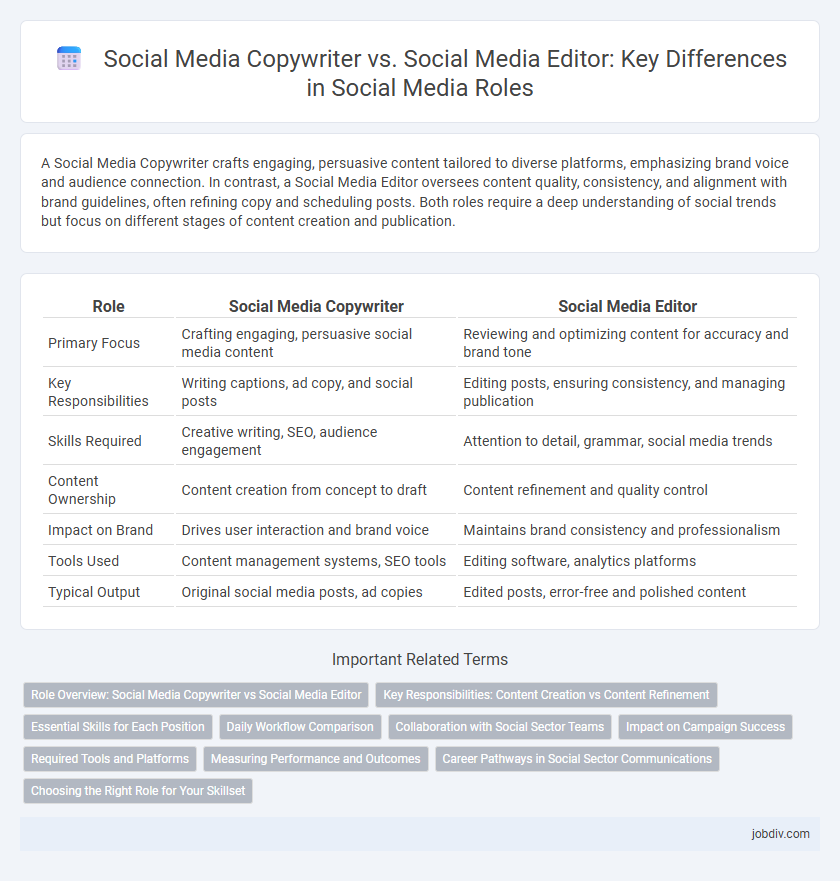A Social Media Copywriter crafts engaging, persuasive content tailored to diverse platforms, emphasizing brand voice and audience connection. In contrast, a Social Media Editor oversees content quality, consistency, and alignment with brand guidelines, often refining copy and scheduling posts. Both roles require a deep understanding of social trends but focus on different stages of content creation and publication.
Table of Comparison
| Role | Social Media Copywriter | Social Media Editor |
|---|---|---|
| Primary Focus | Crafting engaging, persuasive social media content | Reviewing and optimizing content for accuracy and brand tone |
| Key Responsibilities | Writing captions, ad copy, and social posts | Editing posts, ensuring consistency, and managing publication |
| Skills Required | Creative writing, SEO, audience engagement | Attention to detail, grammar, social media trends |
| Content Ownership | Content creation from concept to draft | Content refinement and quality control |
| Impact on Brand | Drives user interaction and brand voice | Maintains brand consistency and professionalism |
| Tools Used | Content management systems, SEO tools | Editing software, analytics platforms |
| Typical Output | Original social media posts, ad copies | Edited posts, error-free and polished content |
Role Overview: Social Media Copywriter vs Social Media Editor
A Social Media Copywriter crafts engaging and persuasive content tailored to diverse platforms, focusing on brand voice and audience connection. A Social Media Editor curates, refines, and schedules posts to maintain consistent messaging and optimize engagement metrics across channels. Both roles collaborate to enhance social media presence but emphasize content creation versus content management.
Key Responsibilities: Content Creation vs Content Refinement
Social Media Copywriters specialize in crafting original, engaging content tailored to target audiences, emphasizing brand voice, messaging, and persuasive calls to action. Social Media Editors focus on refining and optimizing this content by ensuring consistency, correcting grammar, enhancing readability, and aligning posts with platform-specific best practices. Both roles collaborate to produce polished content that maximizes user engagement and brand impact across social media channels.
Essential Skills for Each Position
Social media copywriters excel in crafting compelling, concise messages that drive engagement and brand voice consistency, often requiring strong creativity and mastery of language nuances. Social media editors focus on content quality control, scheduling, and analyzing performance metrics to optimize reach, demanding skills in content strategy and platform-specific expertise. Both roles necessitate a deep understanding of audience behavior and social media algorithms to effectively enhance online presence.
Daily Workflow Comparison
A Social Media Copywriter primarily crafts engaging posts, captions, and promotional content tailored to target audiences, ensuring brand voice consistency across platforms. In contrast, a Social Media Editor oversees content curation, schedules posts, monitors engagement metrics, and refines copy for optimal performance. Both roles collaborate closely but differ in focus, with copywriters emphasizing creation and editors prioritizing distribution and analytics-driven adjustments.
Collaboration with Social Sector Teams
Social Media Copywriters craft targeted messages that resonate with specific audiences, while Social Media Editors refine content for clarity, tone, and consistency. Collaboration between these roles and social sector teams enhances campaign effectiveness by aligning messaging with organizational values and community needs. This partnership ensures authentic storytelling, maximizes engagement, and drives impactful social change.
Impact on Campaign Success
A Social Media Copywriter crafts compelling, targeted messaging that drives audience engagement and conversion rates, directly influencing campaign success by optimizing content for platform-specific algorithms. A Social Media Editor refines this content, ensuring consistency in brand voice and adherence to style guidelines, which enhances the overall quality and professionalism of the campaign. Together, their collaboration maximizes reach and impact, improving key performance indicators such as click-through rates and social shares.
Required Tools and Platforms
Social Media Copywriters primarily utilize content creation tools like Google Docs, Grammarly, and Canva to craft engaging posts, while leveraging platforms such as Facebook, Instagram, and LinkedIn to optimize reach. Social Media Editors depend on project management software like Trello or Asana, alongside social media analytics tools such as Hootsuite, Sprout Social, and Buffer to schedule posts, analyze performance, and ensure brand consistency. Both roles require proficiency in SEO tools like Google Analytics and keyword research platforms to enhance content visibility and engagement.
Measuring Performance and Outcomes
Social media copywriters focus on crafting engaging content that drives audience interaction, with performance measured through metrics like click-through rates, shares, and conversion rates. Social media editors oversee content quality and consistency, analyzing engagement metrics such as reach, impressions, and audience sentiment to evaluate overall campaign success. Both roles utilize analytics tools to optimize strategies and improve social media ROI based on data-driven insights.
Career Pathways in Social Sector Communications
Social Media Copywriters specialize in crafting engaging, persuasive content tailored to diverse audiences, often concentrating on brand voice and messaging consistency across platforms. Social Media Editors oversee content strategy, ensuring quality control and alignment with organizational goals, while managing editorial workflows and performance metrics. Career progression in social sector communications may lead Copywriters to become Editors, Content Managers, or Communications Directors, emphasizing strategic oversight and cross-functional collaboration.
Choosing the Right Role for Your Skillset
A Social Media Copywriter specializes in crafting engaging, persuasive content tailored to target audiences, emphasizing creativity and strong writing skills to drive brand messaging across platforms. In contrast, a Social Media Editor focuses on curating, refining, and optimizing content for consistency, tone, and style, ensuring alignment with the overall social strategy and brand voice. Selecting the right role depends on whether your strengths lie in original content creation or in editing and managing content flow to maintain strategic coherence.
Social Media Copywriter vs Social Media Editor Infographic

 jobdiv.com
jobdiv.com